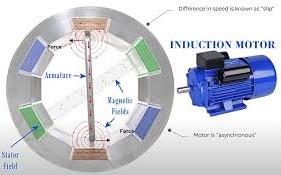Mutual induction is when current is induced in a coil due to changing magnetic flux of a second coil nearby. The changing magnetic flux in the first coil links with the second coil inducing an e.m.f in it.
Demonstrating mutual induction
The figure below consists of two coils P and S , battery, a. c power source, rheostat, galvanometer and switch connected as shown.

When we close the switch K, the point on the galvanometer in the second coil deflects in one direction. It then returns to zero. When we open the switch, the pointer deflects to the opposite direction before falling back to zero. when we increase the primary current, more deflection is noted in either direction. If we replace a d.c source with an a.c power source , the pointer vibrates about point zero.
Explaining the observations on the demo
When we closed the switch, current in the primary coil increases from zero to maximum within a short time. As the current builds up, magnetic flux in the primary coil increases from zero to its maximum value. This change links with the secondary coil inducing an e.m.f in the secondary coil.
Deflection of the galvanometer indicates that current is flowing in the secondary coil where it is connected. The current flow is momentarily. It flows once and stops. This is because the induced e.m.f in the secondary coil is momentarily . It happens when the current in the primary coil is building up from zero to maximum. When the current reaches the maximum value, the magnetic flux stops changing in the primary coil. Therefore, there is no further induction in the primary coil.
Opening the switch causes the primary current to decay from maximum to zero. This happens in a very short time. Consecutively, magnetic flux in the primary coil linking with the secondary coil falls from maximum to zero. This causes changing magnetic flux in the primary coil that induces an e.m.f in the secondary coil.
Induced e.m.f due to current decay
We observes more deflection when switch is opened than when the switch is being closed. This shows that the induced e.m.f in the secondary coil is much higher when switch is opened than when it is closed. The reason behind this is that current in the circuit takes much shorter time to decay than to build up.
Increasing current in the primary coil causes deflection on the galvanometer. This indicates that increasing current in primary coil causes changing magnetic flux in that coil hence continued induction of e.m.f in the secondary coil.
Continuously decreasing current in the primary coil causes an e.m.f in the secondary coil due to decreasing magnetic flux linking with the secondary coil.
From the Lenz’s law; the direction of the induced current when current is building up is as indicated in the diagram below:

when the current is decaying, the direction of current according to Len’z law is as shown.

Increasing efficiency in mutual induction
The induced e.m.f in the secondary coil can be increased by winding the primary and secondary coils on a soft iron rod. The soft iron concentrates magnetic flux in both coils. See the figure below.

A more efficient way of linking magnetic flux between the two coils is by winding the two coils on a soft iron ring as shown.

More induced e.m.f can be attained by having more turns in the secondary coil. The e.m.f is induced in each turn of the secondary coil. This occurs because the magnetic flux of the primary coil links with each of the turns. The total e.m.f is thus the summation of the individual e.m.f from each turn.

